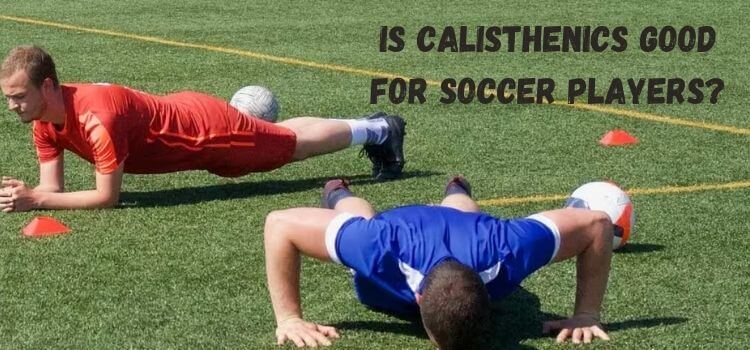As an Amazon Associate, I earn from qualifying purchases
Using body weight to train for resistance, Calisthenics is a form of exercise that is derived from two Greek words, kalos (beautiful) and synthenos (strength). In this type of resistance training, body weight is used as resistance. It has gained popularity in recent years due to its simplicity, accessibility, and effectiveness. In this article, we explore whether Calisthenics is beneficial for soccer players and how it can enhance their performance on the field.

Introduction to Calisthenics
Calisthenics involves performing a variety of movements, such as push-ups, squats, lunges, and planks, without the need for equipment. It focuses on improving strength, endurance, flexibility, and coordination.
Unlike traditional weightlifting, which often requires access to gym equipment, Calisthenics can be performed anywhere, making it an ideal training method for athletes, including soccer players.
Importance of Strength and Conditioning in Soccer
As a physically demanding sport, soccer requires players to possess a variety of physical attributes, such as strength, speed, agility, and endurance, in order to be successful.
Soccer performance can be enhanced with strength and conditioning, which will keep players able to endure the rigors of the game and perform at their best for the entire game.
How Calisthenics Benefits Soccer Players
Improves Core Strength and Stability
In order to dribble, pass, and shoot with precision and power, soccer players need a strong core. It improves balance, stability, and posture, all of which will enhance balance, strength, and posture.
Calisthenics exercises such as planks and leg raises target the core muscles, helping to strengthen and stabilize the midsection.
Enhances Balance and Coordination
Soccer requires players to maintain balance and coordination while performing dynamic movements such as changing direction, dribbling past opponents, and making quick turns.
Calisthenics exercises like single-leg squats and balance drills help to improve proprioception and body awareness, enabling players to move more efficiently on the field.
Builds Functional Strength
A person’s functional strength refers to their ability to perform everyday activities and sports-specific movements efficiently and effectively.
Calisthenics focuses on developing functional strength by engaging multiple muscle groups simultaneously through compound exercises such as push-ups and pull-ups.
This type of strength is particularly beneficial for soccer players as it translates directly to their performance on the field.
Increases Flexibility and Mobility
Flexibility and mobility are essential for soccer players to perform various skills and techniques effectively while reducing the risk of injuries.
Calisthenics incorporates dynamic stretches and range of motion exercises that improve flexibility and mobility, allowing players to move more freely and fluidly during matches.
Specific Calisthenics Exercises for Soccer Players
Push-ups
Push-ups strengthen the chest, shoulders, triceps, and core muscles, which are involved in activities such as shielding the ball, holding off opponents, and maintaining balance while changing direction.
Squats
Squats target the quadriceps, hamstrings, glutes, and core muscles, improving lower body strength and power for activities like jumping, sprinting, and tackling.
Lunges
Lunges work the quadriceps, hamstrings, glutes, and calf muscles, enhancing leg strength and stability for movements such as acceleration, deceleration, and changing direction.
Planks
As a result, planks engage core muscles, such as the abdominals, obliques, and lower back, which promote core stability and endurance for maintaining posture and resisting external forces.
Jumping Exercises
The explosive power in the legs developed by jumping exercises like box jumps and plyometric drills is crucial for winning aerial duels, heading the ball, and executing powerful shots.
Incorporating Calisthenics into Soccer Training
Pre-season Preparation
In the pre-season, soccer players can use Calisthenics to build strength, endurance, and mobility before transitioning to more sport-specific drills and exercises.
In-season Maintenance
In-season training in Calisthenics focuses on maintaining strength, flexibility, and conditioning while minimizing fatigue and injury risk. Calisthenics can be incorporated into regular training sessions as part of a comprehensive conditioning program.
Off-season Recovery and Development
Players can recuperate from the previous season’s physical demands during the off-season and focus on their individual growth in the off-season.
Calisthenics can be used to address specific weaknesses, improve overall fitness, and prepare for the upcoming season.
Case Studies and Success Stories
Several professional soccer players attribute their success to incorporating Calisthenics into their training routines. Examples include improved agility, enhanced endurance, and reduced risk of injuries.
Common Myths and Misconceptions
Addressing Concerns Calisthenicsg Up
One common misconception about Calisthenics is that it can lead to excessive muscle gain and bulkiness, which may be better for soccer players who require agility and speed.
However, Calisthenics can be tailored to foCalisthenicsgth-to-weight ratio rather than sheer muscle size.
Clarifying Misconceptions about Flexibility
According to some people, Calisthenics lacks training when compared to other forms of exercise like yoga or Pilates.
However, many calisthenics exercises, which incorporate dynamic stretches and mobility drills, improve flexibility and range of motion.
Expert Recommendations and Training Tips
Fitness trainers and coaches recommend using inCalisthenicscalisthenics in soccer training programs to improve overall athleticism, reduce injury risk, and enhance on-field performance.
They emphasize the importance of proper form, progression, and consistency in calisthenics training.
Conclusion
In conclusion, Calisthenics offers numerous benefits for soccer players, helping to improve strength, flexibility, balance, and coordination. Calisthenics can reduce injury risk and enhance soccer players’ performance on the field by including them in their training regimens.
Whether used as a standalone Calisthenics or Integrated into a comprehensive conditioning program, Calisthenics can play a valuable role in soccer players’ development.
Frequently Asked Questions (FAQs)
No, Calisthenics can be tailored to focus on functional strength rather than excessive muscle gain, allowing soccer players to maintain agility and speed.
Calisthenics can be performed 2Calisthenics week, depending on individual fitness lCalisthenicsaining goals.
Soccer players should avoid exercises that place excessive stress on the joints or Calisthenics, such as weighted exercises or advanced gymnastics movements.
Beginners can begin by practicing basic exercises and progress gradually as their strength and confidence grow. Calisthenics is suitable for all fitness levels.
Results from calisthenics training can vary depending on factors such as consistency, intensity, and individual fitness levels. However, noticeable improvements in strength, flexibility, and overall fitness can typically be seen within a few weeks to a few months of consistent training.
As an Amazon Associate, I earn from qualifying purchases


